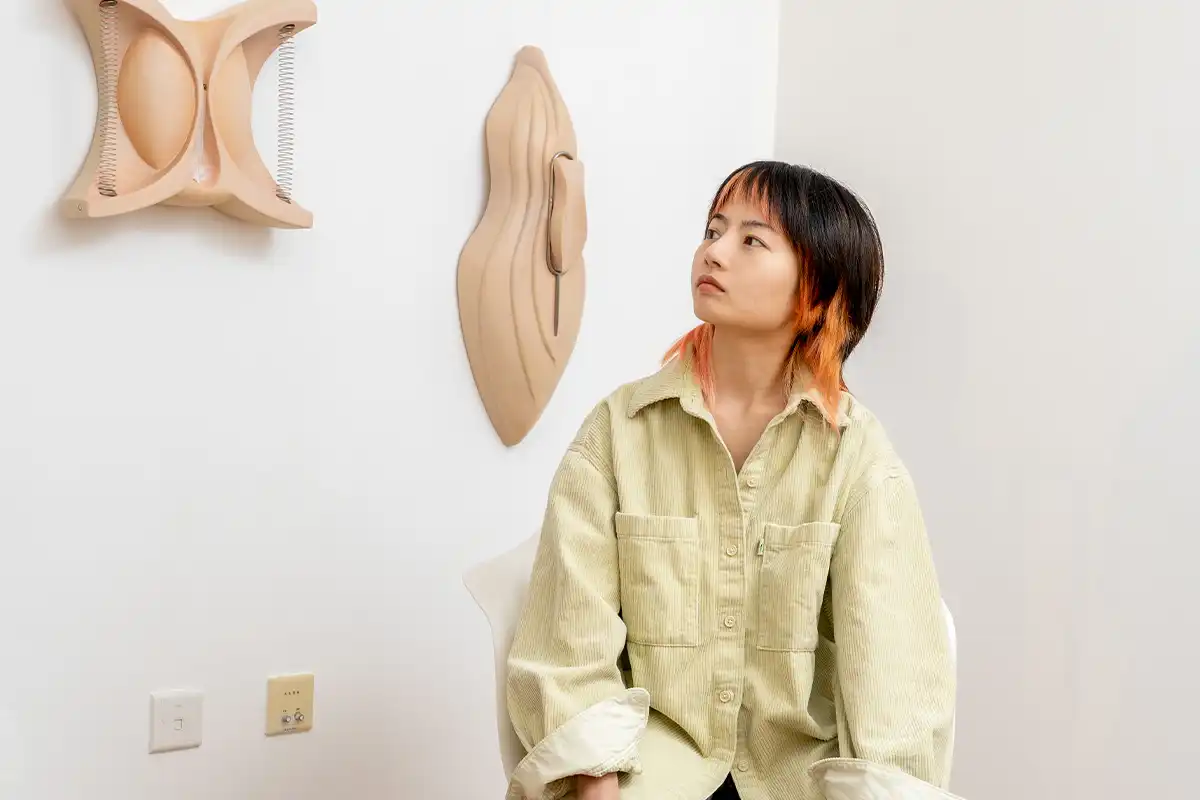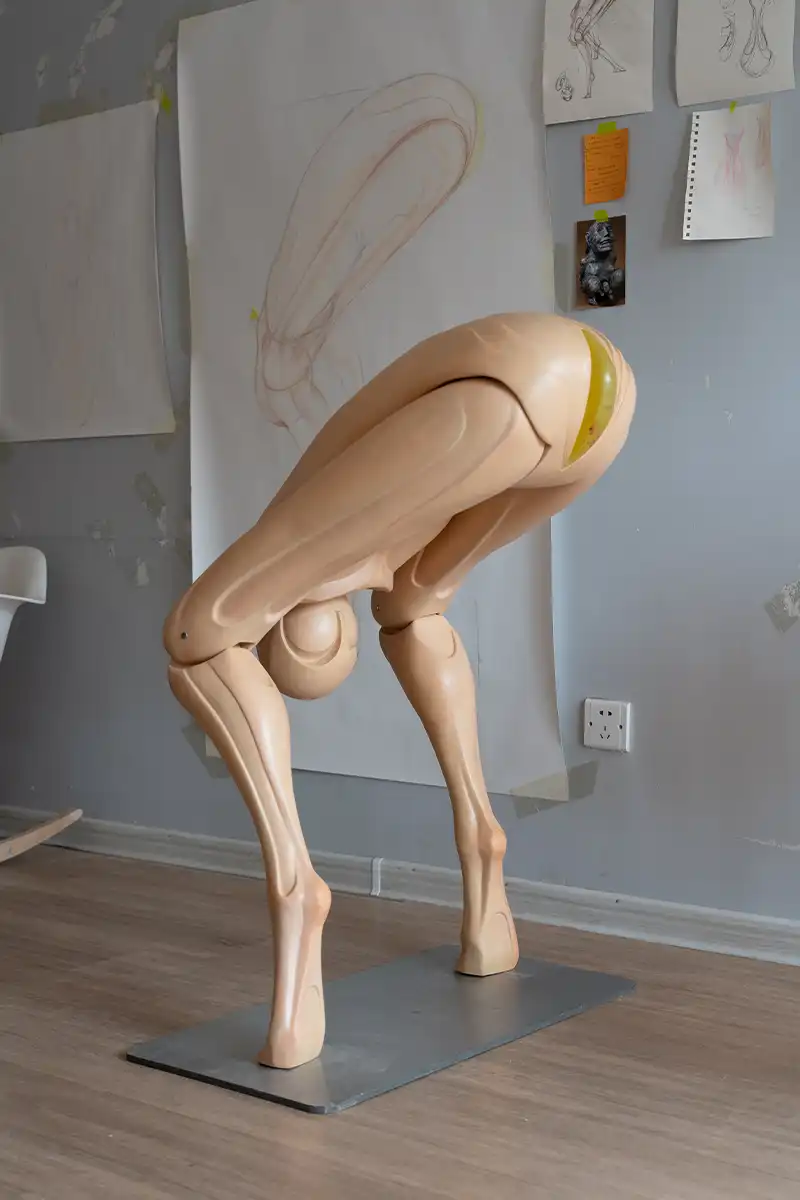Liao Wen for Bodies and Souls, a group exhibition for Cassina Projects curated by Manuela Lietti and in collaboration with Capsule Shanghai
Liao Wen is one of China’s most creative young women artists and she works primarily with wooden sculpture to investigate the human body, its organs and membranes. Her work is included in Bodies and Souls, a group exhibition curated by Manuela Lietti for Cassina Projects in collaboration with Capsule Shanghai.
Body as a medium of perception – Manuela Lietti for Cassina Projects
In the artist’s production, the female body, mythological origins and natural extracts are recurring themes, and the ancient and contemporary co-exist without conflicting. This series was inspired by a dialogue with curator Manuela Letti, as the artist explains: «My earlier series ‘The Flesh Shop’ showed many parts of the body, and the new series expands on this focus, but takes a completely different perspective». The artist explores the role of the body as a conduit of perception, not merely as a material presence or an aesthetic object, drawing inspiration from ancient Roman Votives and Catholic Ex-voto paintings.
She keeps saying: «I am curious if the body is not injured, would we be so focused on body perceptions in daily life?In the new series ‘Sensation’, I am practicing using purely sculptural language, such as lines, volume, relationship between parts, and materials, to express body perception. For example, the work Squeeze, which will be shown at Cassina, presents the tension from the upper abdomen, while Itch is inspired by the strong sensation when one is about to sneeze. When making the works, I gained unprecedented focus and sensitivity on body perceptions, trying to figure out how I feel and eventually visualizing it».
Liao Wen and her human body’s distortion
Her research on puppetry explores and exposes the human body’s distortion, yet it is an interest and passion that she just developed as an adult. In her childhood, Liao Wen never played with puppets or marionettes: «I came into contact with humanoid creations after I became an adult, so I can look at them with childlike simplicity and innocence, and, at the same time, understand and empathize with them with adult-like thinking».
Perhaps it was the absence of humanoid dolls in her childhood that stimulated a strong curiosity and sensitivity toward puppets and the human body form: «My path to sculpture was quite roundabout. I first came into contact with woodcarving when I went to Prague to study marionette in 2017, and I continued to do marionette-related research, production and performance after I came back from the trip.
At the same time, I was also exploring with silicone to make works that represent body parts. Although these two simultaneously-developing lines of works were not fully matured at the time, they allowed me to accumulate a lot of hands-on experience, and led me to feel the charm of sculpture and its significance to me».
Marionettes and puppets – studying art in China
After studying at Sichuan Fine Arts Institute, Liao Wen furthered her studies with a master’s degree in experimental art from the Central Academy of Fine Arts China: «My experience of studying printmaking in college has influenced the way I work. For example, when making prints, you need to rationally control variables, experiment and make mistakes, and accept certain randonness, which are similar to the problems I often encounter when making sculptures.
When making prints, you need to think about positive and negative spaces, lines, and light and shadow – all key elements in my relief sculptures. The experience in the Department of Experimental Art in graduate school helped me break free from specific mediums and working methods, freeing me to explore materials, forms and concepts». She keeps explaining: «I love sculpture, and there is a voice in my heart that keeps telling me: ‘I want to do it; I can do it’».
Caryatids Greece and the women’s body value
The human body has always been a major source of inspiration and fascination in art history: cave paintings depicted hunters. Caryatids were sculptures of women used as architectural and decorative elements in ancient Greece.
Throughout the centuries the human figure has been used to tell stories or express beliefs, or to explore the meaning of being human: «My work focuses on bodily experience, exploring the relationship between body, gender and social culture through daily body perception, ritual and medicine. For me, the body is the inner universe of a person. First, the body is an aesthetic object. In daily life, my retina and brain automatically store detailed characteristics of other people’s bodies, such as skin, nails, wrinkles, teeth, hair, movements and postures
When I recall a person, these images resurface in my mind frame by frame. I am intrigued by how these traits on the surface reveal a person’s long-term life experience, and how they present themselves in front of others. I appreciate these minutiae, gathering these details like an omnivorous collector without judgment of value. It is through the body, rather than through language or physical objects, that I get an initial understanding of people and the world.».
Liao Wen – Rites of Seasons and Poisons or Antidotes series
In Chinese culture, the body is seen as a physical manifestation of one’s spiritual and emotional state, and its health and well-being are considered essential for overall harmony and balance. «A body can immediately reflect the state of the mind. The body, as a person’s inner universe, not only reflects one’s state of being, but also reveals customs and the collective subconscious of a group». Traditional Chinese medicine places a strong emphasis on the interconnectedness of the body, mind, and spirit, and uses techniques such as acupuncture, massage, and herbal remedies to restore balance and promote wellness.
«In the ‘Rites of Seasons’ and ‘Poisons or Antidotes’ series, I blurred the boundaries among human, animal and botanical bodies by looking into the body in rituals, and created unfamiliar visual experiences that resonate with the viewers. Finally, there are many mysterious passages inside the body, and at the end of the passages are glands. The motifs of water droplets and embryos appear in many of my works. They manifest themselves as breasts, tonsils, cysts, tears, urine, uterus. I love these forms because they symbolize the primordial life force. Body fluids and soft tissues flow, connect and penetrate deep in the body».
Almost Collapsing Balance at the gallery Capsule Shanghai, Liao Wen
In 2021, at her solo exhibition ‘Almost Collapsing Balance’ at the gallery Capsule Shanghai, Liao Wen featured smooth, carved-wood sculptures of twisted and bent bones and joints: « At the beginning of the outbreak of the epidemic in 2020, as a fresh graduate, I was at a loss in the face of the world in disorder, and anxious because I did not have any clear ideas about where my work was going. I started to rethink all my past practices, and extract and combine those elements that touched me the most. For example, marionettes rely on external support to move or maintain a certain posture.
I started to think whether it is possible to use the innate characteristics of marionettes to create free-standing sculptures with flexible joints. I wanted the marionettes to have a certain independence and be balanced by their own strength. So I tried to capsule a sense of being on the edge and being at a limit through the tension at the flexible joints, which inspires a strong emotional response. This is how I started the series of self-standing sculptures in the ‘Almost Collapsing Balance’ series».
Liao Wen’s Birds of passage initiative
In 2019, Liao Wen started an ongoing initiative called ‘Birds of Passage’ to address the displacement of China’s over 300 million migrant workers who have relocated from rural areas to major cities in quest of a better life.
«Birds of Passage was made in 2019 during a residency project under the collaboration between 33 Space and Guan Shanyue Art Museum in Shenzhen. It has to do with the city I live in: Shenzhen is a young city. After Reform and Opening-Up, it transformed from a small fishing village to a metropolis. People from all over the nation migrated here to start new lives. Under the surface of prosperity and vitality, the issues of cultural identity and sense of belonging are rarely discussed.
Creating puppet self-portraits of people
Every year over the Lunar New Year holiday, the city is almost empty because people return to their original hometown like birds of passage. 2019 is the second year I have been living in Shenzhen. Subconsciously, I was probably trying to seek answers to my own questions of sense of belonging: who are you? Where are you from? If you have to pick a spot in the city that touches you the most, where would you choose?»
The artist encouraged a variety of displaced people to create puppet self-portraits that they could each name and customize: «This work means a lot to me. It is the only work I have done with participants so far. During the process, every participant asked: Why are you doing this? Is this art? How do you artists make a living? These questions are easy to explain to someone who knows and loves art, but inexplicable to someone who knows nothing about art and struggles to make a living.
For them the issue of art can even be a luxury or cruelty. As I interact with them, I learned to explain the intention of the work in plain language. Their full participation confirmed to me that this work is at least valuable to them. This also confirms what I have always thought: art should evoke and present real emotional experiences».
Women condition in China and the cultural, social, and economic barriers
Historically, women artists in China faced cultural, social, and economic barriers that limited their opportunities to pursue their creative interests and achieve recognition in the arts: «Starting from my mother’s generation (60s), due to the economical growth, women had better opportunity for education, and are relatively free to obtain job opportunities through hard work. My generation (90s), due to the single-child policy, Reform and Opening-Up, and globalization, the only daughter in a family can get more educational resources and parents’ attention than the previous generation.
I think it is difficult for women to pursue freedom and live for themselves. As one of my favorite writers Elena Ferrante wrote in La frantumaglia: ‘Even mother’s seamstress, even if they are both women, are daughters and mothers, they can’t accept their mother’s body.’ Our unique and lively bodies are gradually put on various covers by different tailors, and you can’t see the body’s curves underneath. I started to think how I would view the women around me if these veils were removed». Although the situation has improved in recent decades, the challenges faced by women artists persist and gender inequality remains an issue.
Liao Wen’s future projects in New York and Shanghai
Liao Wen’s figures express emotional and psychological pain and anguish that people sometimes or often experience in their lifetimes. As she explains, her research still has a wide road ahead: «In May 2023, I will be presenting a solo project at Frieze New York with Capsule Shanghai. In this project I will continue to develop the ‘Sensation’ series and explore different possibilities of capturing bodily perceptions. I don’t ask myself to be an advocate of a certain concept or style, so I never presuppose whether my work would influence people. Every piece of my work carries my true feelings and thoughts; I will be satisfied if it evokes even just a momentary resonance from the viewer».
Liao Wen
Liao Wen lives and works in Shenzhen, China. She graduated from the printmaking department of Sichuan Fine Arts Institute in 2016, and received a Master’s degree in Experimental Art from the Central Academy of FineArts China in 2019.




















